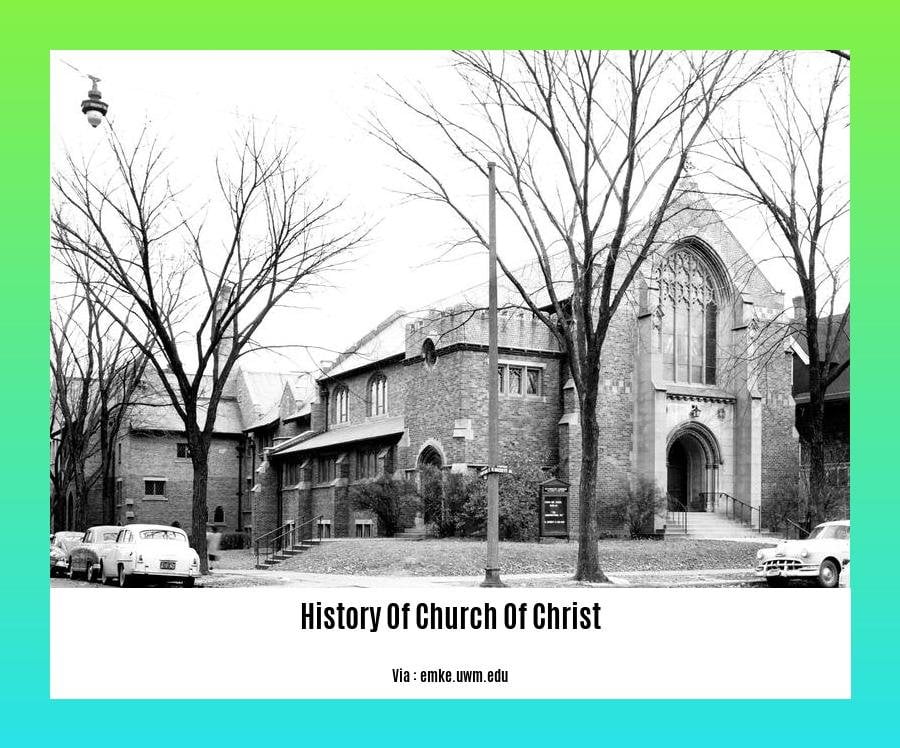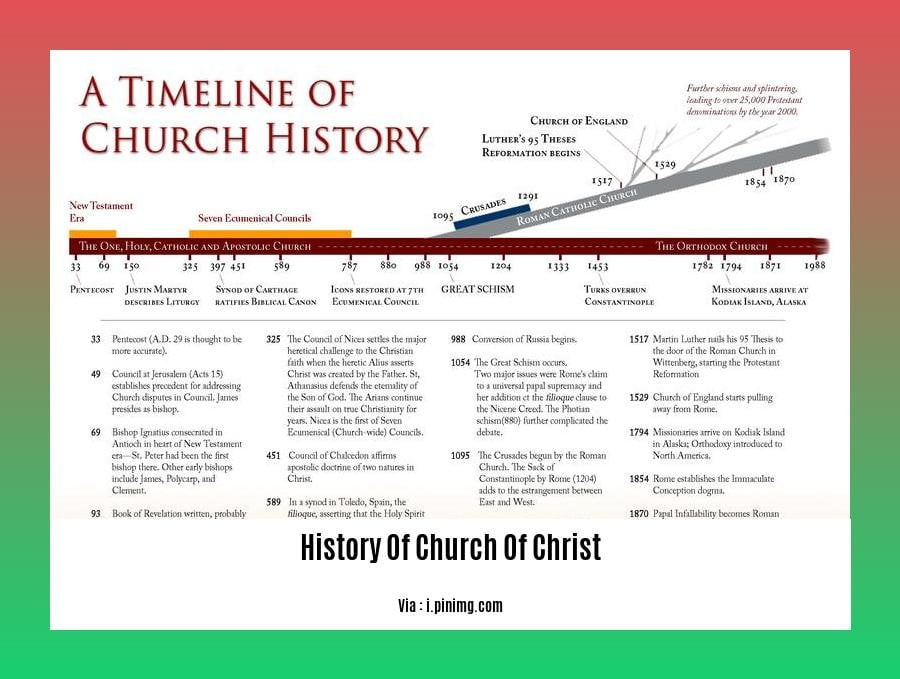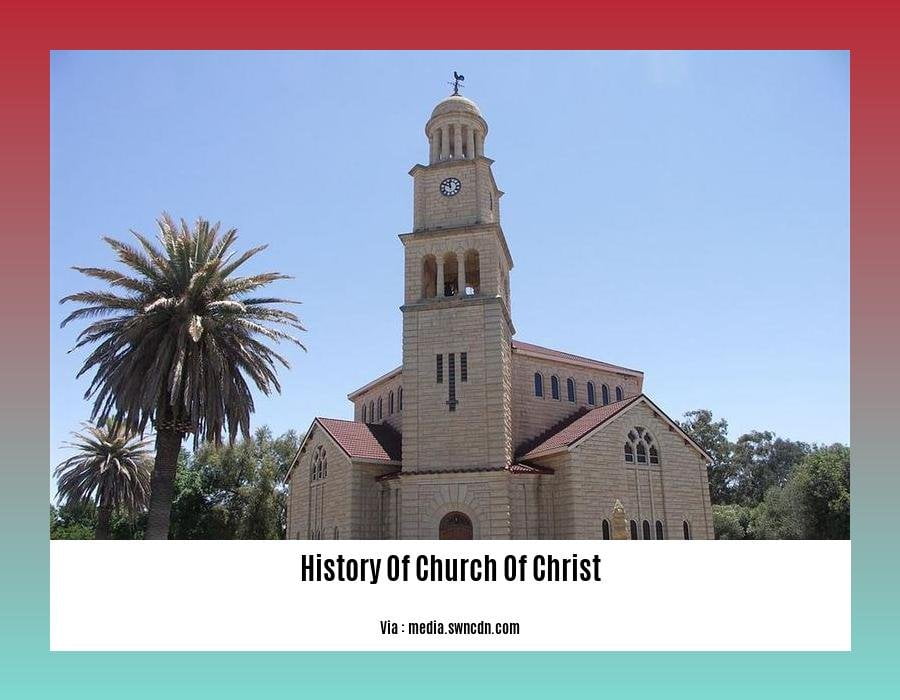Step into the annals of history and discover the enduring legacy of the Church of Christ. From its humble beginnings to its profound impact on the religious landscape, this article takes you on a journey through the centuries, shedding light on the remarkable story of the Church of Christ. Prepare to delve into a rich tapestry of faith, tradition, and the profound influence that has shaped Christianity as we know it today.
Key Takeaways:
-
The Churches of Christ emerged in the 19th century in the United States as part of the Restoration Movement, a movement seeking to unify all Christians and restore the original New Testament church practices.
-
The Churches of Christ are a group of churches that initially appeared in both the United Kingdom and the United States in the early 19th century. The movement sought guidance through Christ for the church.
-
Within the Church of Christ, the lineage can be traced back to the initial establishment by Jesus Christ during the 1st century AD, according to their history.
History of the Church of Christ

From the ashes of division, the Church of Christ arose in the 19th century, guided by a burning desire to reclaim the purity and unity of the early Christian church. Rooted in the Restoration Movement, a movement that sought to restore the original practices and beliefs of the first-century church, the Church of Christ emerged as a beacon of hope for those yearning for a deeper connection with God.
The Restoration Movement and the Birth of the Church of Christ
The Restoration Movement, fueled by the passion of Alexander Campbell, Barton W. Stone, and other like-minded individuals, was a clarion call for a return to the simplicity and authenticity of the apostolic church. They believed that the true church had been corrupted by centuries of tradition and dogma and that it was time to strip away the layers of human interpretation and return to the pure teachings of the Bible.
Seeking Unity Through the Restoration of Scripture
The Church of Christ, embodying the spirit of the Restoration Movement, sought to unite all Christians under the banner of Scripture alone. Rejecting creeds, dogmas, and man-made traditions, they embraced the Bible as the sole authority for faith and practice. This unwavering commitment to Scripture became the cornerstone of their identity, guiding their beliefs, worship practices, and church governance.
A Church Rooted in the New Testament
The Church of Christ traces its lineage directly to the church established by Jesus Christ in the first century AD. They believe that the church described in the New Testament is the only true church and that all other denominations are departures from the original design. This conviction shapes their understanding of everything from baptism and communion to church leadership and the role of women in the church.
A Legacy of Mission and Evangelism
From its inception, the Church of Christ has been marked by a strong emphasis on mission and evangelism. Inspired by the Great Commission, they have sent missionaries to every corner of the globe, spreading the message of Jesus Christ and planting new churches. Their commitment to sharing the gospel has resulted in a global community of believers who are united by a common faith and a shared history.
Preserving the Heritage While Embracing the Future
The Church of Christ, while deeply rooted in its history and traditions, is not stagnant or resistant to change. They recognize that the world is constantly evolving and that the church must adapt to meet the needs of a changing society. While they remain committed to the core principles that have defined them for centuries, they are open to new ideas and approaches that align with their mission and values.
-
Wondering how those twinkling Christmas lights came to be? Learn the history of Christmas tree lights and how they evolved from candles to modern electric lights.
-
Discover the captivating origins of Christmas tree ornaments, from their humble beginnings in ancient times to the cherished traditions they represent today. Read the history of Christmas tree ornaments.
Major Developments in the 19th and 20th Centuries

In the 19th and 20th centuries, Christianity underwent profound transformations, influenced by various cultural, intellectual, and social forces. Here are some key developments that reshaped the Christian landscape:
Evangelical Revivals:
- The 19th century witnessed a surge in evangelical revivals, particularly in Protestant countries. These revivals emphasized personal conversion, emotional religious experiences, and a commitment to spreading the gospel.
- Notable figures like Charles Finney and Dwight L. Moody led these revivals, igniting spiritual awakenings and leaving a lasting impact on Christian practices and beliefs.
Liberalism and Modernist Theology:
- The 19th century also saw the rise of liberal or modernist theology, influenced by modern biblical scholarship and the Enlightenment’s scientific and cultural influences.
- Liberal theologians sought to align Christianity with modern thought, challenging traditional doctrines and emphasizing the importance of reason and individual conscience.
The Roman Catholic Church’s Response:
- The Roman Catholic Church in Europe staunchly opposed liberal theology, engaging in culture wars in countries like Germany, Italy, Belgium, and France.
- The Church condemned liberalism as a threat to its authority and clashed with secular governments seeking to limit its influence in society.
Secularism and Pietistic Revivals:
- In Europe, there was a general shift towards secularism, with many people moving away from religious devotion and Christian teachings.
- In contrast, pietistic revivals emerged within Protestantism, emphasizing personal piety, devotional practices, and a return to traditional values.
The Impact of Modernism:
- Modernism in Christian theology led to a critical examination of the Bible, questioning traditional interpretations and the authority of Scripture.
- This resulted in shifts in attitudes towards Christian doctrines, with some theologians embracing more liberal and progressive interpretations.
Key Takeaways:
-
19th-century evangelical revivals: Led by individuals like Charles Finney and Dwight L. Moody, these movements focused on personal conversion, emotional experiences, and spreading the gospel.
-
Liberal or modernist theology: Emerged in response to modern scholarship and Enlightenment influences. Liberal theologians sought to reconcile Christianity with modern thought, emphasizing reason and individual conscience.
-
The Roman Catholic Church’s response: The Church resisted liberal theology, clashing with governments and condemning liberalism as a threat to its authority.
-
Secularism and pietistic revivals: A shift towards secularism in Europe was countered by pietistic revivals within Protestantism, emphasizing personal piety and traditional values.
-
Modernism’s impact: Modernism led to a critical examination of the Bible and Christian doctrines, fostering more liberal and progressive interpretations.
Relevant URL Sources:
- Christianity in the 19th century – Wikipedia
- Modernism in Christian Theology | Encyclopedia.com
Development of the Church of Christ in the United States
The 19th century was a tumultuous time for Christianity in America. The Second Great Awakening had led to the formation of new denominations, and the rise of liberal theology was challenging traditional beliefs. In this context, the Church of Christ emerged as a movement that sought to restore the purity of the early church.
The Church of Christ was founded in 1809 by Thomas Campbell, a Scottish immigrant who had been ordained as a Presbyterian minister. Campbell was dissatisfied with the state of the Presbyterian Church, which he believed had become too worldly and corrupt. He sought to return to the simplicity of the early church, as described in the New Testament.
Campbell and his followers held a series of meetings in western Pennsylvania, where they debated the nature of the church and its ordinances. Out of these meetings, the Church of Christ was born. The new denomination rejected creeds and dogmas, emphasizing the Bible as the sole authority for faith and practice. It also emphasized the importance of baptism by immersion and the Lord’s Supper.
The Church of Christ grew rapidly in the 19th century, spreading from Pennsylvania to other parts of the United States. By the end of the century, there were over 100,000 members of the Church of Christ in the United States.
The Church of Christ has continued to grow in the 20th and 21st centuries. Today, there are over 1.5 million members of the Church of Christ in the United States. The denomination is active in a variety of ministries, including evangelism, missions, and social justice.
Key Takeaways:
- The Church of Christ emerged in the United States in the 19th century as a movement that sought to restore the purity of the early church.
- The denomination rejects creeds and dogmas, emphasizing the Bible as the sole authority for faith and practice.
- The Church of Christ has grown rapidly in the United States, and today there are over 1.5 million members.
- The denomination is active in a variety of ministries, including evangelism, missions, and social justice.
Sources:
- The Church of Christ in the United States
- The History of the Church of Christ
Influence and Significance of the Church of Christ
Diving into the rich history of the Church of Christ, we uncover its profound impact on the religious landscape. Emerging from the embers of the Restoration Movement, the Church of Christ’s mission was as simple as it was ambitious – to return to the essence of Christianity’s founding principles, free from doctrinal distractions and tradition’s burden.
Key Takeaways:
-
Restorationist Roots: Originating from the Restoration Movement, the Church of Christ sought to restore the purity and practices of the early Christian church, embracing a non-creedal approach and focusing solely on the Bible as the guide for faith and practice.
-
Congregational Autonomy: Churches of Christ value congregational autonomy, empowering each congregation to govern itself without hierarchical control, fostering a sense of independence and self-determination.
-
Simplicity in Worship: Striving for simplicity, the Church of Christ rejects rituals, ceremonies, and creeds, believing that true worship involves heartfelt prayer, singing, and communion, reflecting the simplicity of the early church.
-
Missionary Zeal: The Church of Christ has a strong commitment to spreading the gospel, sending missionaries worldwide to share their beliefs and establish new congregations, contributing to the global reach of Christianity.
-
Educational Emphasis: Recognizing the importance of education, the Church of Christ has established colleges and universities, nurturing intellectual growth and preparing students for various roles within the church and society.
-
Social Activism: Engaging in social issues, the Church of Christ has been at the forefront of movements for social justice, civil rights, and peace, demonstrating its commitment to addressing societal challenges.
-
Global Presence: With a presence in over 150 countries, the Church of Christ has a significant global impact, promoting unity, understanding, and cooperation among diverse cultures and communities.
[Sources]
– Churches of Christ
– History of the Churches of Christ in the United States
FAQ
Q1: What was the Restoration Movement, and how did it influence the formation of the Churches of Christ?
Q2: How do Churches of Christ differ from other Protestant denominations in terms of their beliefs and practices?
Q3: What are some notable historical events that have shaped the development of the Churches of Christ?
Q4: How has the Church of Christ adapted to changing cultural and societal landscapes over time?
Q5: What are some significant contributions that the Churches of Christ have made to Christianity and society at large?
- Unveiling Bernhard Caesar Einstein’s Scientific Achievements: A Legacy in Engineering - July 15, 2025
- Uncover who is Jerry McSorley: CEO, Family Man, Business Success Story - July 15, 2025
- Discover Bernhard Caesar Einstein’s Scientific Contributions: Unveiling a Legacy Beyond Einstein - July 15, 2025















